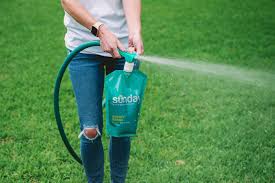Sunday Grass, scientifically known as Cynodon dactylon, is a type of plant that grows in many places around the world. It’s commonly found in lawns, parks, and even along roadsides. This grass is special because it has a unique ability to withstand different weather conditions and still thrive.
The leaves of Sunday Grass are quite narrow and flat. They feel smooth to the touch and are usually a vibrant shade of green. One interesting thing about this grass is that it can grow in patches, spreading across the ground and creating a soft, green carpet-like surface. People often enjoy walking or sitting on this grass because of its comfortable texture.
What makes Sunday Grass even more remarkable is its ability to survive in both sunny and shady areas. It can handle hot temperatures and still stay green, making it a popular choice for lawns in places with warm climates. This grass is also quite resilient to foot traffic, meaning that even if people walk or play on it, it can recover and keep growing.
Another fascinating feature of Sunday Grass is its capability to spread quickly through its stems, which are called “stolons.” These stolons grow horizontally along the ground and send out new roots to establish new plants. This is why you might see patches of this grass popping up in various spots.
Gardening enthusiasts and landscapers often appreciate Sunday Grass for its low-maintenance nature. It doesn’t require excessive watering or fertilizing to stay healthy, which makes it a convenient choice for those who want a nice-looking lawn without spending too much time on upkeep.
In addition to its practical benefits, Sunday Grass can also play a role in preventing soil erosion. The dense network of roots that it forms helps hold the soil together, preventing it from washing away during heavy rains. This can be particularly important in areas where soil erosion is a concern.
Sunday Grass, or Cynodon dactylon, is a remarkable plant that can be found in various parts of the world. Its ability to thrive in different weather conditions, its comfortable texture, and its contribution to preventing soil erosion make it a valued presence in gardens and landscapes. Whether you’re looking for a resilient and attractive lawn or a natural way to protect the soil, Sunday Grass certainly deserves appreciation for its unique qualities.
Read Also: Number of Blocks Required to Rise above Ground Level in Constructing a Concrete Pond
Growing Sunday Grass

Sunday Grass, scientifically known as Cynodon dactylon, is a hardy and versatile grass species that can be a great addition to your lawn or garden. Whether you’re a seasoned gardener or just starting out, here’s a simple growing guide to help you cultivate and care for Sunday Grass:
1. Choose the Right Location: Sunday Grass thrives in both sunny and partially shaded areas. Choose a location with well-draining soil and good sunlight exposure. Avoid areas with heavy foot traffic, as Sunday Grass can get damaged easily when walked on frequently.
2. Soil Preparation: Prepare the soil by loosening it to a depth of about 6 inches. If the soil is compacted, consider adding organic matter like compost to improve its structure and drainage.
4. Watering: Keep the soil consistently moist until the grass establishes itself, which usually takes a few weeks. Afterward, water deeply but less frequently to encourage deep root growth. Allow the soil to dry out slightly between watering to prevent overwatering.
5. Fertilization: Sunday Grass doesn’t require excessive fertilization. Apply a balanced, slow-release fertilizer in the spring and again in late summer or early fall. Follow the package instructions for the recommended dosage.
6. Mowing: Regular mowing is important to keep Sunday Grass looking neat and healthy. Set your lawnmower to a height of around 2 to 2.5 inches for optimal results. Avoid cutting more than one-third of the grass’s height in a single mowing session.
7. Pest and Disease Control: Sunday Grass is generally resistant to pests and diseases. However, keeping your lawn well-maintained and practicing good hygiene can help prevent any potential issues. If you notice any unusual discoloration or growth patterns, consult a gardening expert for advice.
8. Overcoming Weeds: Maintaining a healthy lawn through proper watering, mowing, and fertilization can help prevent weed growth. If weeds do appear, consider using manual removal or targeted herbicides.
9. Winter Care: Sunday Grass tends to go dormant in colder months. Reduce watering during this time and avoid fertilization. Resume regular care in the spring when the grass starts to green up again.
10. Aeration and Dethatching: Over time, the soil can become compacted and thatch (a layer of dead grass) can accumulate. Periodic aeration and dethatching can help improve soil aeration and water penetration, allowing your Sunday Grass to thrive.
Remember, patience is key when growing Sunday Grass. It may take some time for the grass to establish itself and fill in. With proper care and attention, you can enjoy a lush, green lawn that adds beauty to your outdoor space.
Caring for Sunday Grass
Caring for your Sunday Grass, scientifically known as Cynodon dactylon, involves a few simple but essential steps to ensure its health and vibrancy. Follow this care guide to keep your lawn or garden looking lush and inviting:
1. Watering: Water deeply and infrequently to encourage deep root growth. In the early stages, water daily to keep the soil consistently moist. As the grass establishes, gradually reduce the frequency to 2-3 times per week. Allow the soil to dry slightly between watering sessions.
2. Mowing: Regular mowing helps maintain the appearance and health of your Sunday Grass. Set your lawnmower to a height of about 2 to 2.5 inches. Avoid cutting more than one-third of the grass’s height at a time, as this can stress the grass and weaken it.
3. Fertilization: Sunday Grass doesn’t demand frequent fertilization. Apply a balanced, slow-release fertilizer in the spring, as well as in late summer or early fall. This provides the necessary nutrients for healthy growth without promoting excessive growth that needs frequent mowing.
4. Weed Control: A healthy, well-maintained lawn can naturally resist weed growth. However, if weeds do appear, consider using manual removal or targeted herbicides. Regular mowing and proper watering can also help prevent weeds from taking over.
5. Aeration and Dethatching: Over time, the soil can become compacted, and a layer of thatch (dead grass) can accumulate. Aerating the soil by creating small holes helps air, water, and nutrients reach the grassroots. Dethatching involves removing the accumulated dead material to prevent suffocation of the grass.
6. Pest and Disease Management: Sunday Grass is generally hardy, but keep an eye out for any signs of pests or diseases. Insects like chinch bugs can sometimes infest the grass. If you notice any unusual discoloration, wilting, or other signs of distress, consult a gardening expert for appropriate action.
7. Seasonal Care: During the winter months, Sunday Grass tends to go dormant. Reduce watering and refrain from fertilization during this period. As spring approaches and the grass begins to green up, resume regular care routines.
8. Traffic Management: While Sunday Grass is resilient, excessive foot traffic can lead to compaction and stress. Avoid heavy use of the grass during wet conditions, as this can result in soil compaction and damage.
9. Sunlight and Shade: Sunday Grass can tolerate both full sunlight and partial shade. However, in areas with limited sunlight, the grass might be less dense and lush. Trim overhanging branches or obstacles that block sunlight to encourage healthy growth.
10. Observation and Adjustment:
Pay attention to the condition of your Sunday Grass. If you notice areas of poor growth, adjust your care routine accordingly. It’s essential to adapt your watering, mowing, and maintenance practices to the specific needs of your lawn.
By following these care guidelines, you can ensure that your Sunday Grass remains a vibrant and attractive part of your outdoor space. With a little attention and effort, you’ll be rewarded with a resilient and beautiful lawn that enhances the overall appeal of your home.
Read Also: Find out: “Earthen Pond vs Concrete Pond” Which one is Better?
Benefits and Uses of Sunday Grass

Sunday Grass, scientifically known as Cynodon dactylon, offers a range of benefits and uses that make it a valuable addition to various landscapes and environments. Here are some of the advantages and practical applications of this versatile grass:
1. Erosion Control: Sunday Grass forms a dense network of roots that help hold the soil together. This makes it an effective natural solution for preventing soil erosion on slopes, embankments, and other areas prone to erosion.
2. Low-Maintenance Lawns: One of the significant benefits of Sunday Grass is its low-maintenance nature. It requires less frequent watering, fertilization, and mowing compared to other grass varieties. This makes it a practical choice for those who want an attractive lawn without spending excessive time on upkeep.
3. Drought Resistance: Sunday Grass has a remarkable ability to tolerate drought conditions. It can survive and remain green even in periods of water scarcity, making it a suitable choice for regions with limited water resources or seasonal droughts.
4. Traffic Tolerance: This grass can withstand moderate foot traffic without significant damage. Its ability to recover quickly after being walked on makes it ideal for lawns, parks, and recreational areas that receive regular use.
5. Lawn Aesthetics: Sunday Grass can create a lush, green carpet-like appearance, enhancing the aesthetic appeal of lawns and landscapes. Its ability to spread and cover the ground gives lawns a uniform and attractive look.
6. Playground Surfaces: Given its resilience to foot traffic, Sunday Grass can be used in playgrounds and play areas. It provides a comfortable and safe surface for children to play on while maintaining its appearance.
7. Livestock Grazing: In some regions, Sunday Grass is used for grazing by livestock such as cattle and horses. Its high tolerance for grazing and ability to withstand trampling makes it a practical forage option in certain agricultural settings.
8. Soil Stabilization: Sunday Grass’s root system not only prevents soil erosion but also helps stabilize loose soils. This can be beneficial in construction sites, road embankments, and other areas where soil stability is crucial.
9. Golf Course Fairways: Many golf courses utilize Sunday Grass on fairways due to its ability to provide a consistent playing surface. Its resistance to foot traffic and its aesthetic qualities contribute to its popularity in golf course maintenance.
10. Medicinal Uses: In traditional medicine, extracts from Sunday Grass have been used for their potential health benefits. They are believed to possess anti-inflammatory, anti-oxidant, and antimicrobial properties.
11. Bee Attraction: Sunday Grass can produce small flowers that attract pollinators like bees. It can contribute to supporting local ecosystems and biodiversity by providing a food source for these beneficial insects.
In summary, Sunday Grass offers a range of benefits and practical applications that make it a valuable asset in various contexts. Its ability to control erosion, resist drought, tolerate traffic, and enhance the appearance of lawns and landscapes underscores its versatility and importance in gardening, landscaping, and even agricultural practices.
Read Also: Here are 5 things that happen when you eat too much honey
